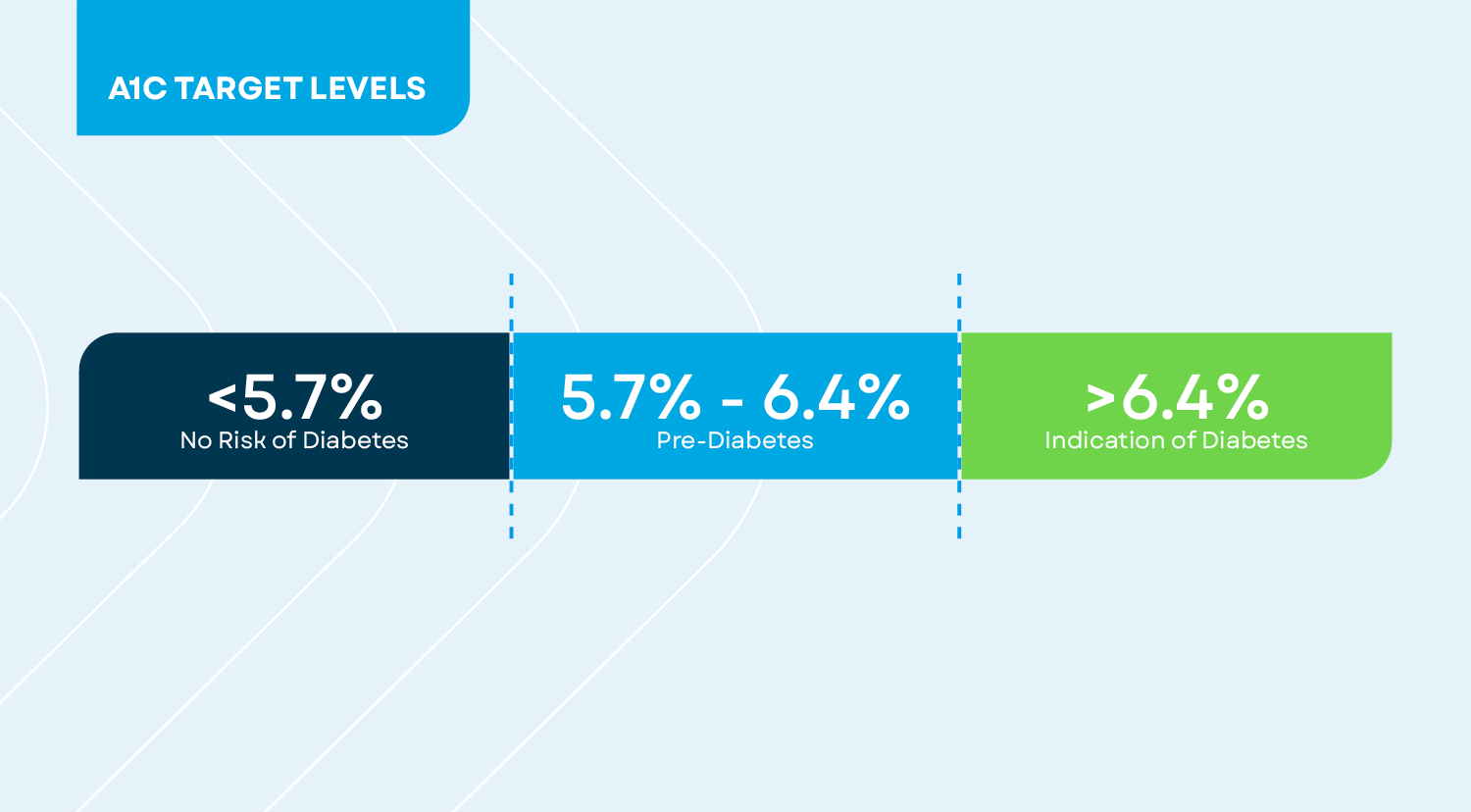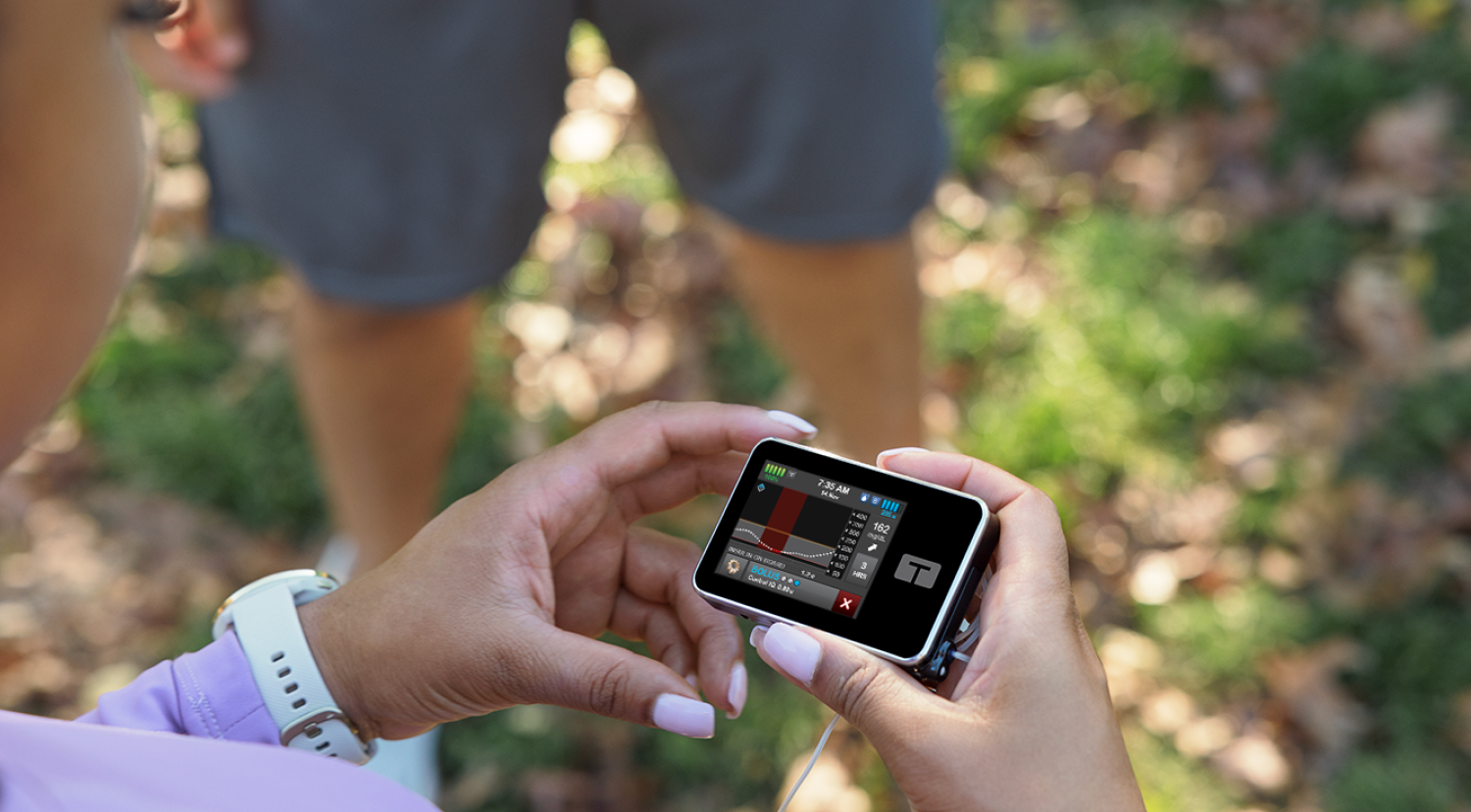Medically reviewed by Dr. Jordan Pinsker, Vice President & Medical Director, Tandem Diabetes Care.
A common term when talking about type 1 diabetes or type 2 diabetes is “A1c.” What is A1c and what does it have to do with diabetes? This article will break down A1c, what it means for someone living with type 1 diabetes, type 2 diabetes, or prediabetes. It will also include tips for lowering A1c.
What is A1c?
A1c, also called HbA1c, glycated hemoglobin, or hemoglobin A1c, is a measurement that healthcare professionals use to calculate the average of someone’s blood sugar levels over a period of about three months. This is done through an A1c test.
It sounds intimidating, but it’s a simple process.
Whenever someone eats food, the body breaks down (metabolizes) that food in order to produce energy. A big part of that process is converting sugar into energy.
Everyone has red blood cells, which are responsible for transporting oxygen throughout the body.
These red blood cells get coated with sugar — and the amount of sugar that clings to the proteins on these red blood cells is called the A1c. This number is then converted to an estimated blood sugar.
Red blood cells last about three months, so healthcare professionals do an A1c test to see how high blood sugars have been for the last few months.
“A1c is a very valuable tool you can use to understand how high your blood sugar has been, on average, over the last few months,” said Dr. Jordan Pinsker, Vice President and Medical Director at Tandem Diabetes Care, who is also a renowned pediatric endocrinologist. “Although it can vary across individuals and people with certain medical conditions, it is a very good estimate of your average blood sugar.”

What is a Normal A1c?
Healthcare professionals tend to stay away from words like “good, bad, or normal” when describing a diagnosis. Rather, there is a percentage range they use to evaluate blood sugars to make a diagnosis of prediabetes, type 1 diabetes, or type 2 diabetes.
An A1c result that comes back below 5.7 percent does not represent a risk for diabetes.
An A1c result that’s between 5.7 and 6.4 percent is considered “prediabetes,” which can be a precursor to type 2 diabetes.
An A1c that is greater than 6.4 percent is an indication of diabetes.
It should be noted that type 1 diabetes is rarely diagnosed through routine screening with an A1c test. Type 1 diabetes is an autoimmune disease that is typically diagnosed when someone is experiencing symptoms of diabetes, such as frequent urination, weight loss, or even severe symptoms such as diabetic ketoacidosis. These symptoms can appear rapidly. In that case, an A1c test can help confirm the diagnosis.
Type 2 diabetes, however, can take much longer to develop and diagnose because it is generally caused by insulin resistance that develops over time.
Read more about the differences between type 1 diabetes and type 2 diabetes.
What is an A1c Test?
An A1c or HbA1c test is a blood test that is conducted by a healthcare professional. It can even be done in your doctor’s office, sometimes with a fingerstick test with results available in just a few minutes.
It can also be done with a home kit you can buy at a pharmacy.
However, it is most often done during an annual physical exam when blood is drawn for other measurements – such as cholesterol or triglycerides.
No fasting is required for an A1c test because it is measuring the percentage of sugar on red blood cells over a span of a few months.

How Often Should I Get an A1c Test?
There are certain factors that can impact how often someone should get an A1c test.
The general recommendation is that people 45 and older should be getting a screening HbA1c test. If the results are less than 5.7 percent, then they can repeat it every couple of years as part of their annual physical examination.
However, if someone is at a greater risk for type 2 diabetes, or has been identified as having prediabetes, they should follow the recommendation of their healthcare provider for when to get screened and how often they should repeat the test.
Some of the risk factors for type 2 diabetes could include age, genetics, ethnicity, obesity, or high cholesterol.
Please note that these risk factors may not be an indication of type 1 or type 2 diabetes for all individuals. Please consult a healthcare professional for further information.
It is recommended that people living with either type 1 diabetes or type 2 diabetes get their A1c measured at least twice per year.
“If you have diabetes, checking your A1c is important because it can help you discover times when your blood sugar might be changing when you don’t know,” Dr. Pinsker explained. “For example, if you have high blood sugar after a meal, but you are not typically checking blood sugars at that time, this could be reflected in your A1c. You can then discuss with your doctor how to best address this.”
How Do I Lower A1c?
Having an A1c in the recommended range is an essential part of diabetes management. But it doesn’t happen overnight. Lowering A1c is a gradual process that can take months before real progress is shown.
The ability to lower A1c can also depend on whether someone is living with type 1 diabetes or type 2 diabetes.
For people living with type 1 diabetes, lowering their A1c can be influenced by their choice of daily insulin therapy. Whether they use multiple daily injections (MDI), insulin pens, or an insulin pump, it’s important for them to be diligent about their insulin therapy because people with type 1 diabetes are insulin dependent.

Some insulin pumps, like the t:slim X2 insulin pump from Tandem Diabetes Care, can automate insulin dosing and provide automated insulin delivery (AID) for people living with type 1 diabetes.
In fact, the American Diabetes Association recently recommended that AID be part of diabetes management in its Standards of Care in Diabetes. Read more about what this means for AID systems on the Tandem Diabetes Care blog.
Someone with type 1 diabetes should make a plan with their healthcare provider and come up with strategies for lowering their A1c. These could range from changing their diet and exercise to altering their insulin therapy.
Lowering A1c with type 2 diabetes is different. Because someone living with type 2 diabetes may or may not be taking insulin, and is primarily treating insulin resistance, there are different options. For example, someone with type 2 diabetes could possibly lower their A1c through a combination of lifestyle change, increased physical activity, and weight loss.
There are also certain medications available for people living with type 2 diabetes to lower their A1c that are either pills or injections. This approach is often used before there is a need to take insulin.
“A1c can be a guide for you to help manage your diabetes, to help you come up with options, and to improve your blood sugar control,” Dr. Pinsker said. “This way you and your doctor can work together to make changes to enhance your health.”
Unless otherwise noted, all medical information was provided by Jordan Pinsker, MD, of Tandem Diabetes Care, Inc.
Important Safety Information
RX ONLY. The t:slim X2 pump and Control-IQ technology are intended for single patient use. The t:slim X2 pump and Control-IQ technology are indicated for use with U-100 insulin only. t:slim X2 insulin pump: The t:slim X2 insulin pump with interoperable technology is an alternate controller enabled (ACE) pump that is intended for the subcutaneous delivery of insulin, at set and variable rates, for the management of diabetes mellitus in people requiring insulin. The pump is able to reliably and securely communicate with compatible, digitally connected devices, including automated insulin dosing software, to receive, execute, and confirm commands from these devices. The t:slim X2 pump is indicated for use in individuals six years of age and greater. Control-IQ technology: Control-IQ technology is intended for use with a compatible integrated continuous glucose monitor (iCGM, sold separately) and ACE pump to automatically increase, decrease, and suspend delivery of basal insulin based on iCGM readings and predicted glucose values. It can also deliver correction boluses when the glucose value is predicted to exceed a predefined threshold. Control-IQ technology is intended for the management of Type 1 diabetes mellitus in persons six years of age and greater.
Warning: Control-IQ technology should not be used by anyone under the age of six years old. It should also not be used in patients who require less than 10 units of insulin per day or who weigh less than 55 pounds.
Control-IQ technology is not indicated for use in pregnant women, people on dialysis, or critically ill patients. Do not use Control-IQ technology if using hydroxyurea. Users of the t:slim X2 pump and Control-IQ technology must: use the insulin pump, CGM, and all other system components in accordance with their respective instructions fozr use; test blood glucose levels as recommended by their healthcare provider; demonstrate adequate carb-counting skills; maintain sufficient diabetes self-care skills; see healthcare provider(s) regularly; and have adequate vision and/or hearing to recognize all functions of the pump, including alerts, alarms, and reminders. The t:slim X2 pump, and the CGM transmitter and sensor must be removed before MRI, CT, or diathermy treatment. Visit tandemdiabetes.com/safetyinfo for additional important safety information.